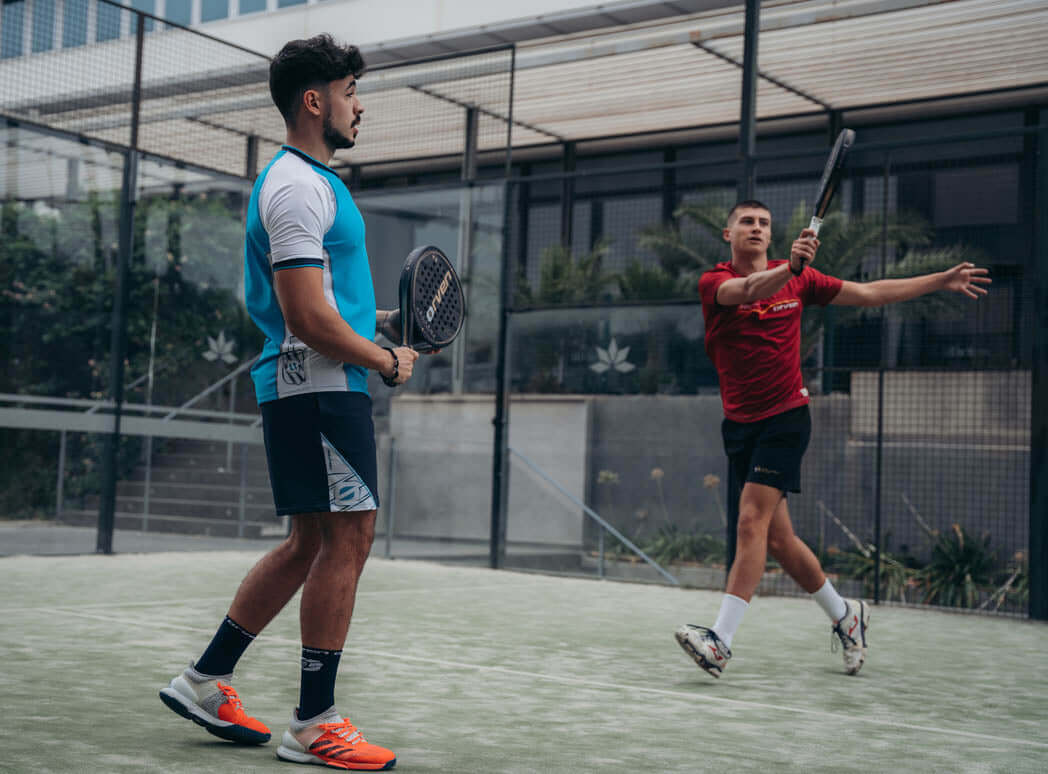When we want to buy a paddle tennis racket we find ourselves with one of the most common questions. How to choose the ideal paddle tennis racket? What should its shape be? Does it have to be power or control? The great variety of shapes and sizes can be confusing, especially for those who are taking their first steps in the world of paddle tennis.
You have no idea how to choose your ideal paddle tennis racket, there are already hundreds of options available? Orven Sport has put together a checklist that will help you narrow down your choices a lot.
How to choose a paddle tennis racket?
- Game regularity : It is not necessary to invest in an expensive paddle tennis racket if you play occasionally.
- Weight : The heavier blades allow more power when hitting the paddle ball.
- Shape : The blades have three shapes: round, teardrop-shaped, and diamond-shaped. Each of them is handled in a specific way.
- Balance : Padel rackets have a low balance or a high balance, it must be taken into account.
- Thickness : The thickness of paddle tennis rackets is widely standardized because the factory molds are equally thick.
- Core : EVA is cheaper and more durable, while foam gives a better feel for the ball.
Knowing the type of player you are is the first step in making sure you have the right racket for your abilities or strengths. Looking at these ten factors in detail will help you make a more informed decision the next time you shop for a racket.
Key factors to choose your paddle tennis racket
Many paddle tennis players, especially those who are new to this sport, hardly think about the type of racket they are going to buy. This can make the wide variety of options quite confusing.
In the end, people usually see a brand that they recognize, either from having seen other players on their local track or in World Padel Tour tournaments. They go for that brand and grab a racket with no idea of the specific properties of that racket. They may get lucky and buy a racket that works very well, although the odds are not in their favor.
Luckily, thanks to a couple of key factors you will be able to narrow down your selection of paddle tennis rackets to those that really benefit you as a player.
1. Weight of the paddle tennis racket
It is surprising the number of players, especially beginners, who have no idea that paddle tennis rackets not only have different weights, but also the great variation that weight has in the handling of the racket.
From my point of view, weight is easily the most important factor to consider. The lighter the racket, the greater the feel of the ball through the point of impact with the racket. Conversely, the heavier the racket, the greater the amount of power that is generated.
What I've observed, even at the professional level, is that most female players perform better with 12-14 ounce rackets, while male players tend to use 12-15 ounce racquets.
Don't forget to factor in frame and grip protector and overgrip/s as they can easily add an extra 20 grams to the weight of your racket.
2. Shape of the paddle tennis racket
Oddly enough, your choice of racket shape can be influenced by where you prefer to play on the court. Your position on the court is usually determined by whether you are a more offensive or defensive player.
In general, right-handed attacking players play on the left side of the court so that they can cover a greater area of the court with their powerful forehands. In most cases, the player who can receive the ball with his right will play a ball through the center of the paddle court.
On the other hand, right-handed defensive players will play on the right side or zone of the paddle tennis court.
In case you're wondering what this has to do with your choice of paddle racquet shape, attacking players often do better with an aggressively balanced racquet that emphasizes power over control. Defensive players need more control in order to better place the ball.
2.1 Diamond-shaped paddle tennis racket
Buying a diamond racket is often an expensive mistake that many beginners make. While it is true that the number one players in the world, Marta Morero and Paquito Navarro, use diamond-shaped rackets to great effect, playing those huge shots that fall from the top of the stands, they can do it with a diamond-shaped racket. because they are expert players. This is one of the most important factors to know how to choose your ideal paddle tennis racket.
A diamond-shaped racket has a very small sweet spot and it takes great skill as a paddle player to hit that sweet spot with every shot. Yes, these rackets give a significant advantage in terms of playing power, but only in the right hands.
In fact, there are some professional players who choose not to use a diamond racket as a way to reduce unforced errors. Therefore, only consider getting a diamond shaped paddle tennis racket if you are an experienced paddle tennis player.
Diamond-shaped rackets have what is called top balance, which means that most of the weight is distributed off the grip and towards the top of the racket. The centrifugal force creates more racquet head speed through the impact area with the ball and gives a sensation that I can only describe as not having a sensation of connecting the ball, but seeing it go flying.
This shape gives the racket a lot of power, but on the other hand, it makes it much more difficult to control. If the racket face is marginally out of angle when you impact the ball, you will almost certainly make a mistake and lose the point.
The sweet spot of the racket is minimal, so this type of racket is only recommended for players who master the entire repertoire of paddle strokes. You also have to be able to hit the ball with enough power and always with the very center of the racket.
If this is your first time switching to a diamond-shaped paddle racket from another type of racket, choose one that is lighter than the one you have been using. That will compensate for the balance being skewed towards the top. Adding an extra overgrip will also shift the balance of the racket slightly lower, making the transition easier.
2.2 Teardrop-shaped paddle tennis rackets
Teardrop rackets strike a fine balance between the power of diamond rackets and the control of round rackets.
Intermediate and advanced players can get the most out of a teardrop racket.
As you gain the experience you need to start hitting more powerful shots, a teardrop-shaped racquet will become more forgiving due to its much larger sweet spot.
For many players, the teardrop racket will be the second racket they buy. For many of us, we won't become strong enough players to justify a diamond racket, but we can enjoy years with a teardrop racket.
As far as racket shape goes, this is by far the most popular. It is the model that represents the largest sales volume in the paddle tennis racket market, and manufacturers are well aware of this.
Professional padel players find these rackets much easier to use because you can feel the ball in the racket as you play your shots.
That's why during the Mexico Open padel tournament in 2019 many of the professional players who favor the power of the diamond-shaped padel racket actually switched to teardrop-shaped rackets in order to cope with nearly 8000 feet. altitude.
2.3 Round paddle tennis rackets

Round paddle tennis rackets are ideal for beginner paddle tennis players. This is especially true for paddle tennis players who come from a tennis playing background.
The reason is that the round paddle tennis rackets have the weight towards the handle. This weight distribution takes most of the power out of the punches being delivered. This is a good thing for new padel players who have a tendency to hit the long ball.
The bottom line of a tennis court is almost 2 meters beyond the net than a paddle tennis court, so having a paddle racket that takes a lot of power away from your shots will help you adapt to playing paddle tennis from your experience in tennis.
Another characteristic of round racquets is that they have a sweet spot that extends across most of the racquet face. This makes them the more forgiving option as you start to learn to hit the ball closer and closer to the center of the racket.
Even intermediate level padel players who play more defensively will benefit from having a round shaped padel racket. Round rackets provide excellent ball control, making them ideal for players whose main strength is ball placement and who never play smashes.
3. The core of your racket: EVA or foam
There are two different types of padel racket core that make the selection process easier. The two types of core material used will be EVA rubber or foam rubber (polyethylene).
In the past, rackets were made of one material or another. Today, manufacturers are increasingly using a mix of both. EVA has a higher bulk density than foam, which allows different racket models to have a different center of balance depending on the ratio of EVA to foam in the racket head.
A good starting point will be to examine the differences between these two materials. This way, based on your needs as a player, you can make a better choice between the two or even if a mix is what you need.
EVA rubber is much harder and more rigid. EVA rackets are ideal for high speed games where the ball travels faster and feels lighter. For example, in the middle of summer, the heat makes the paddle balls have more bounce when the internal gases heat up. The same goes for tracks that are slightly higher in elevation.
Conversely, during the winter when colder and wetter paddle balls feel heavier, using an EVA racket makes ball control much more difficult.
The lack of flex of an EVA core makes it more durable than polyethylene ones. As a material, EVA is much cheaper than polyethylene. This combination of durability and price makes EVA the ideal core for beginner/entry level padel rackets where price can be a barrier to entry for new players.
Rackets that have a soft foam (polyethylene) core will help you feel more of each shot. Also, you won't need a lot of power to control a ball that comes to your racket quickly.
Because a racquet with a polyethylene core has more flexibility at the point of impact with the ball, you will have the feeling that the racquet is "holding" the ball a bit more. You can use this slightly longer contact time with the ball to create more spin on each shot.
The disadvantage of a racquet with a polyethylene core is that due to the elasticity of the foam, you will have much less power on shots.
Over time, polyethylene foam becomes more compressed, which means that the bond between the core and the outer shell becomes weaker. This is what gives polyethylene core racquets the reputation of not being durable.
There are some padel players who play with hard EVA foam in the summer and switch to soft polyethylene foam in the winter to compensate for the feeling of lightness or heaviness of the ball between the two seasons.
For me, that has never been a problem. I like to think it's because I play weekly and the way I play gradually changes throughout the seasons to compensate for heavier or lighter balls. Actually, most likely my padel skills are below the level where you can tell the difference.
From a practical point of view, nowadays many manufacturers have started to use a hybrid of polyethylene and EVA rubber to make the cores of their rackets. This gives rise to a greater variety in the different racket models available. It also means that you can have heavily EVA racquets that can behave similarly to a poly racquet.
All this can start to get very confusing. As a result, some manufacturers have chosen to print a "Ball Out" rating on their packaging. This rating refers to the amount of ball that bounces off the racket face.
In other words, a racket with a high "Ball Release" rating will have great springiness and the ball will bounce off the racket quickly. These rackets behave very similarly to the "old" EVA rackets. It is very possible that these rackets have only EVA cores.
Conversely, racquets with a low "Out Of Ball" rating are softer and spongier, giving you much more ball-in-the-racquet feel throughout your shot. My opinion is that these paddle tennis rackets will be almost completely made of polyethylene rubber.
In most circumstances, it can be difficult to tell which foam is used in a racket just by looking at it. However, thanks to the "Ball Exit" and the very different sound they make when hitting the ball makes it easier to identify.
4. How to choose the best balance for your paddle tennis racket
The two factors we just talked about are those that affect the balance of your paddle tennis racket. These are the shape of your racket, and secondly, how the mix of EVAs and foam is distributed within the core of your racket. This point is important to know how to choose your ideal paddle tennis racket.
Padel rackets are labeled as low, medium or high balance. A low balance racket is one in which the center of balance is close to the grip, providing more control at the expense of power. A high balance racket has a center of balance much higher up the racket face towards the toe. This is better for playing power shots, although it requires more ball control skill.
If you have a high balance racquet and have trouble controlling your shots, consider adding an overgrip. The couple of grams of overgrip will move the center of balance closer to the handle of the racket and therefore give you more control over your shots.
5. Choose the correct thickness
According to the paddle tennis regulations, the maximum thickness is 38 millimeters (one and a half inches). Therefore, you will see that practically all paddle tennis rackets have that thickness.
The reason is simple. Regardless of the materials from which the core or outer skin of the racket is made, the racket will be pressed in a mold as part of the manufacturing process. Therefore, the factory will have to completely modify the mold to make a racket of different thickness. Not only is it expensive to create molds of different thicknesses, but there is also a loss of production time when retooling a factory.
6. The frequency with which paddle tennis is played
One of the factors that will determine how much you are willing to invest in the quality of your paddle tennis racket will be the frequency with which you are going to play and, therefore, the level of play to which you aspire.
If you plan to train and play padel competitively, even at club level, then it makes sense to purchase a racket that best suits your style of play.
If padel is just an occasional social event, then all you need is a cheap racket that allows you to enjoy your time on the court.





Leave a comment
This site is protected by hCaptcha and the hCaptcha Privacy Policy and Terms of Service apply.